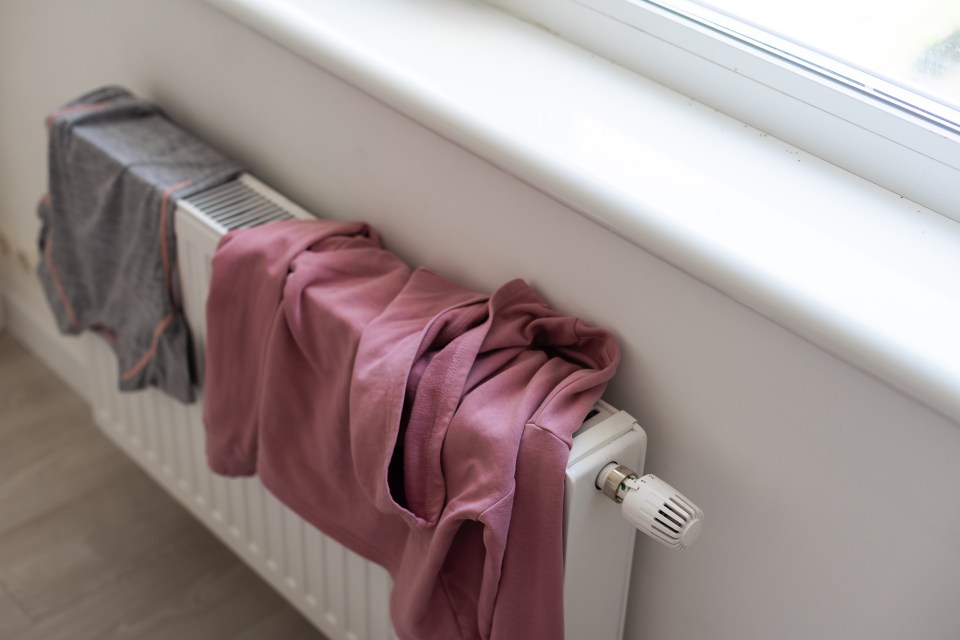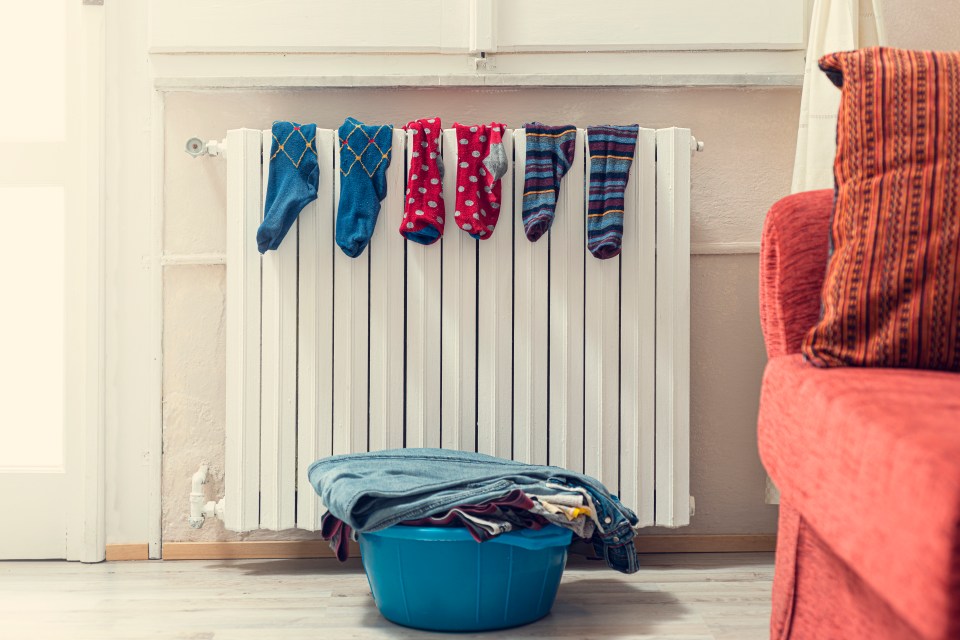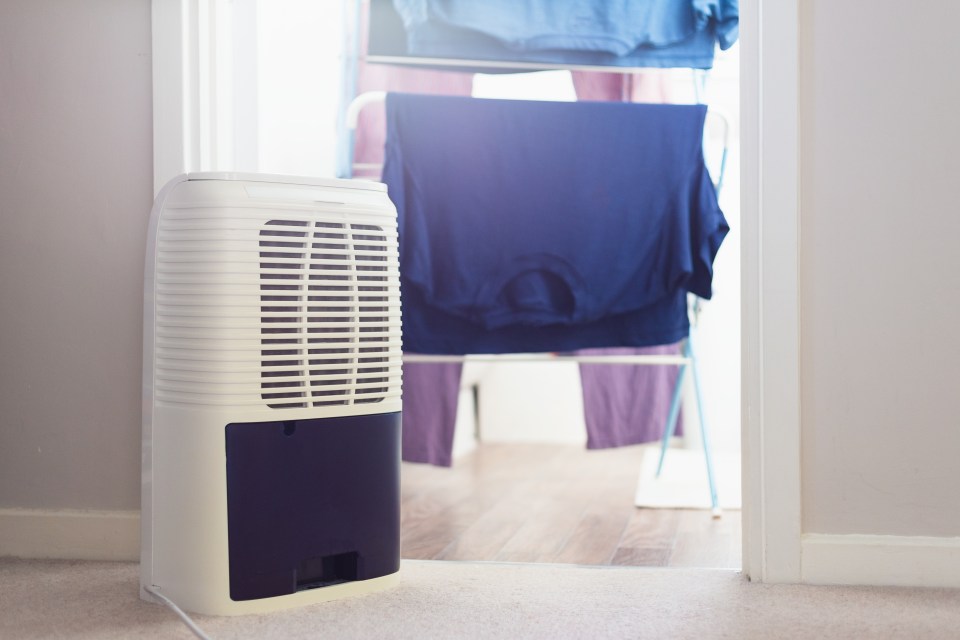DRYING clothes during the cold winter months can be more than just a bit of a pain.
If you go about it the wrong way you could be left with a nasty mould problem, which could damage not just your home but your home but your health too.
Luckily, home pros Jojo Barr and Pollyanna Wilkinson have shared the biggest mistakes out there so you can avoid them.
Speaking on their hit podcast the Ins & Outs, Jojo, who is an interior design expert of House Nine Design, and landscape design guru Polly of Pollyanna Wilkinson Garden Design, explained all you need to know.
“This is really important guys, I cannot stress this enough, Jojo said during the question and answer section of the show.”
“Do not hang clothes on your radiators to dry,” she warned.
The problem is that the moisture from the wet clothes is trapped in the room and can lead to mould, which can be a costly issue to fix.
“That moisture from the clothes is going immediately up into the atmosphere of your room and it cannot escape unless you have open windows, which of course you’re not going to in the winter,” Jojo explained.
“That moisture will turn into mould. Mould spores [are] dangerous, very bad for your health,” she added.
The solution, according to the pro, is to simply open the windows if you are going desperate to dry clothes in a hurry on the radiators.
You can close the doors to the room so the rest of the house doesn’t get cold.
The home whizz also offered another way to dry your clothes inside and avoid mould.
“Ideally you want to get a dehumidifier,” she explained, “because that will pull all the moisture from the air that is coming out of your clothes, it’s really simple.”
“Where do you think that moisture is going to go? It’s going to stick on your ceiling and walls, you’re going to get black mould spores, so bad for you, especially if you’ve got kiddies,” Jojo continued.
If you are struggling to dry your clothes inside, rest assured you’re not the only one.
Mary Tudor took to Mrs Hinch’s Cleaning Tips Facebook group to ask for some advice when it comes to using a dehumidifier to dry laundry indoors.
She posted: “Can anyone please tell me if they have a dehumidifier with dry clothes function on it?
“How long on average to dry the clothes does it need to be on please?”
Her questions received lots of comments, Ally Lambell replied: “We’ve recently bought the MeacoDry ABC and we dry our washing in the conservatory.
“Before we got it the washing would take two to three days to dry jeans as no heating in there but now they’re dry within a day and it costs just pennies to use.”
She added: “It really is worth the money and is on offer £45 less than we paid, plus easy enough to move into other rooms.”
Sue Edwards shared her experience: “I have a twenty litre. I usually run it for about 12 hrs.
How does a dehumidifier work to dry washing?
According to Which?, “dehumidifiers draw excess moisture from the air, helping to combat condensation, prevent mould growth and reduce damp on walls”.
Many dehumidifiers with laundry settings also blast air at the garments – similarly to them being dried outside on a windy day.
Curry’s added: “Clothes can take a long time to dry properly indoors, especially if it’s a humid environment.
“But when you use a dehumidifier, the air surrounding your wet clothes becomes less humid.
“This allows the moisture within the clothes to evaporate more quickly, resulting in shorter drying times.”
To use a dehumidifier for drying clothes indoors, keep it a close to the clothes.
Make sure the items are spaced out across the drying rack or on hangers to allow the airflow to pass through each item.
You might need to rotate the items a few times to ensure all sides are evenly dried.
As for what the best dehumidifier is, The Sun’s Shopping team tried and tested 10 models.
What is mould and how to get rid of it?
Mould is more likely to grow during the winter months.
Olivia Young, Product Development Scientist at Astonish revealed exactly why this is.
“Unfortunately, mould is a common problem many people face during winter. It thrives in conditions that are warm and damp, so your bathrooms are likely to be the most affected place.
“That said, during the colder months most rooms in your home could be vulnerable to mould growing.
“This occurs primarily from condensation that builds up on your windows when you’ve got your radiators on.
“If you think about it, when windows and doors are closed, there’s not much chance for the air to circulate and the moisture to make a swift exit.
“This build up is what can cause dreaded mould to make an appearance, especially in bathrooms, as it creates that warm and wet environment that is a breeding ground for mould.
“If left untreated, not only is it unsightly but it can also pose a serious risk to your health, so it’s really important you treat it.
“The key to tackle mould is to act fast.
“Try to come into as little contact with it as you can. So, grab your gloves, tie up your hair and get to work to remove any signs of mould as soon as you notice them.
“To keep mould at bay, there are some simple solutions you can introduce throughout home.
“The first is keep it ventilated. Yes, even in the cold winter months try to leave your bathroom window open for at least 10/15 minutes post shower or bath. This will get rid of any excess moisture quickly preventing mould gathering.
“If you’re having a repeat problem with mould in one particular area, it might be because the humidity levels are too high. You can get a dehumidifier that will help keep the levels low and reduce the risk of mould returning.
“The golden rule to remember when dealing with mould is the quicker you can treat it, the better. If you leave it, it will only get worse so never ignore it!
“To successfully get rid of mould every time, I recommend opting for the UK’s No 1 Mould & Mildew Remover, that effectively removes mould and mildew stains almost instantly, with no scrubbing necessary.”


